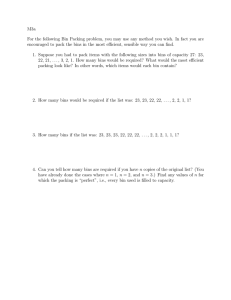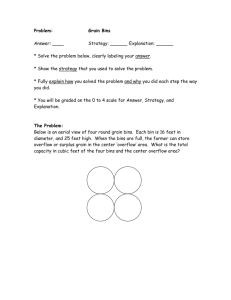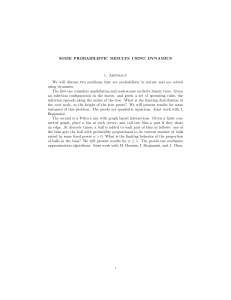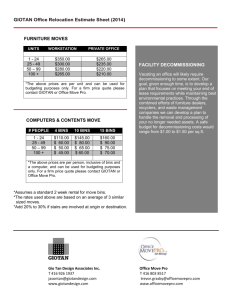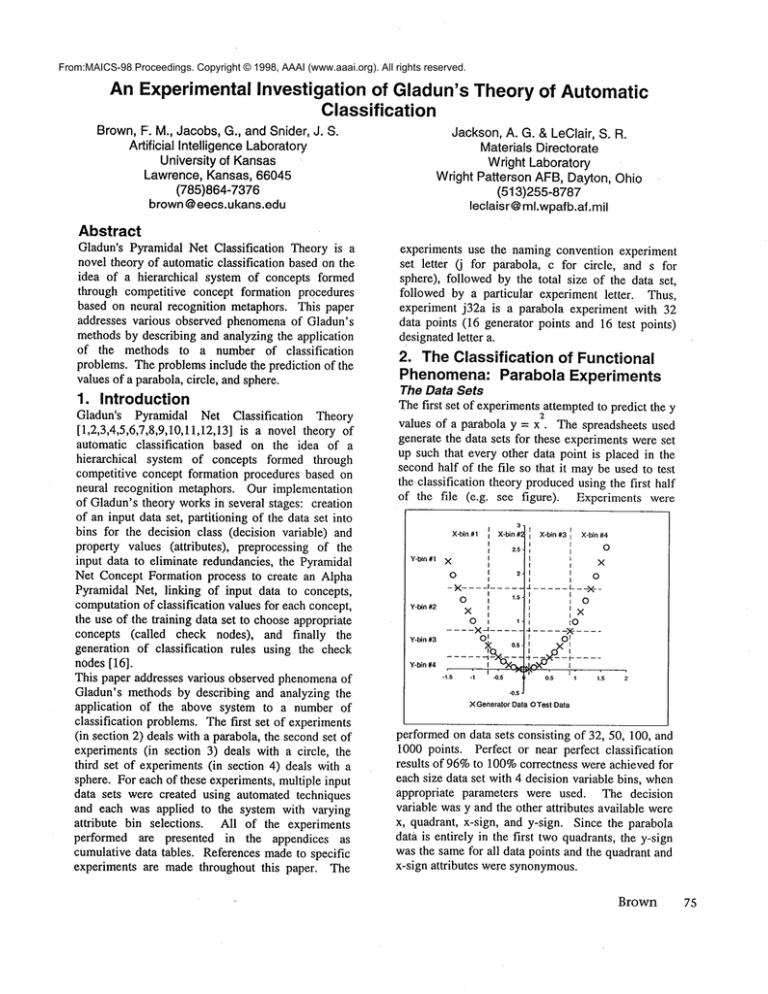
From:MAICS-98 Proceedings. Copyright © 1998, AAAI (www.aaai.org). All rights reserved.
An Experimental Investigation of Gladun’s Theory of Automatic
Classification
Brown,F. M., Jacobs, G., and Snider, J. S.
Artificial Intelligence Laboratory
University of Kansas
Lawrence, Kansas, 66045
(785)864-7376
brown @eecs.ukans.edu
Jackson, A. G. & LeClair, S. R.
Materials Directorate
Wright Laboratory
Wright Patterson AFB, Dayton, Ohio
(513)255-8787
leclaisr@ ml.wpafb.af.mil
Abstract
Gladun’s Pyramidal Net Classification Theory is a
novel theory of automatic classification based on the
idea of a hierarchical system of concepts formed
through competitive concept formation procedures
based on neural recognition metaphors. This paper
addresses various observed phenomenaof Gladun’s
methods by describing and analyzing the application
of the methods to a number of classification
problems. The problemsinclude the prediction of the
values of a parabola, circle, and sphere.
1. Introduction
Gladun’s Pyramidal Net Classification
Theory
[1,2,3,4,5,6,7,8,9,10,11,12,13] is a novel theory of
automatic classification
based on the idea of a
hierarchical system of concepts formed through
competitive concept formation procedures based on
neural recognition metaphors. Our implementation
of Gladun’s theory works in several stages: creation
of an input data set, partitioning of the data set into
bins for the decision class (decision variable) and
property values (attributes), preprocessing of the
input data to eliminate redundancies, the Pyramidal
Net Concept Formation process to create an Alpha
Pyramidal Net, linking of input data to concepts,
computationof classification values for each concept,
the use of the training data set to chooseappropriate
concepts (called check nodes), and finally the
generation of classification rules using the check
nodes [16].
This paper addresses various observed phenomenaof
Gladun’s methods by describing and analyzing the
application of the above system to a number of
classification problems. The first set of experiments
(in section 2) deals with a parabola, the secondset
experiments (in section 3) deals with a circle, the
third set of experiments (in section 4) deals with
sphere. For each of these experiments, multiple input
data sets were created using automated techniques
and each was applied to the system with varying
attribute bin selections. All of the experiments
performed are presented in the appendices as
cumulative data tables. References madeto specific
experiments are made throughout this paper. The
experiments use the naming convention experiment
set letter (j for parabola, c for circle, and s for
sphere), followed by the total size of the data set,
followed by a particular experiment letter. Thus,
experiment j32a is a parabola experiment with 32
data points (16 generator points and 16 test points)
designatedletter a.
2. TheClassificationof Functional
Phenomena:
Parabola Experiments
The Data Sets
The first set of experimentsattempted to predict the y
2
values of a parabola y = x. The spreadsheets used
generate the data sets for these experimentswere set
up such that every other data point is placed in the
secondhalf of the file so that it maybe used to test
the classification theory producedusing the first half
of the file (e.g. see figure). Experiments were
3X-bin #2
X-bin# 1
X-bin#3 ;
X-bin #4
O
2.5i
Y-bin#1 X
X
O
O
--X
Y-bin #2
........
1.5
O
X
Y-bin#3
OI
~,
O
X
~O
|
OI
o.st
¥’bin"
.,:,
0.5
1
1.5
-0,5J
XGenerator
DataOTestData
performedon data sets consisting of 32, 50, 100, and
1000 points. Perfect or near perfect classification
results of 96%to 100%correctness were achieved for
each size data set with 4 decision variable bins, when
appropriate parameters were used. The decision
variable was y and the other attributes available were
x, quadrant, x-sign, and y-sign. Since the parabola
data is entirely in the first two quadrants, the y-sign
was the same for all data points and the quadrant and
x-sign attributes were synonymous.
Brown
75
Appropriate Attribute(s)
Someattributes aid classification more than others.
This often means that one or more attributes are
needed for goodclassification, while others seem to
make no difference whatsoever. In the case of the
parabola experiments, it was found that the quadrant
and y-sign attributes did not make a difference.
However,the x attribute was found to be essential to
goodclassification.
Whenthe system was run on the 50 point data set,
92% correct classification
was achieved when
classifying y into 2 bins using only the x attribute,
both with and without the use of the quadrant, x-sign,
or y-sign attributes (see experimentsj50a, j50e, j50g,
and jS0h).
More Decision Variable Bins
One of the more obvious points to make about
classification is that it is harder to classify data into a
larger number of decision variable bins. Whenonly
2 decision variable bins are used, the system has no
trouble comingup with 100%correct classification,
as long as appropriate attributes are used. The
difficulty of classification dramatically increases as
the numberof decision variable bins increases. There
is always an upper limit on the numberof decision
variable bins that a given data set can reasonably
classify. Smaller data sets, morecomplexdata sets,
and data sets with fewer appropriate attributes will
have a smaller maximum
numberof decision variable
bins.
Ratio of Attribute to Decision Variable Bins
In order to obtain goodclassification there needs to
be a high enoughratio of attribute bins to decision
variable bins. Whenthis ratio is too low the
algorithm does not have degrees of freedom with the
bins available to performgoodclassification.
Whenthe ratio of attribute bins to decision variable
bins is below 2:1 the algorithm achieved around 50%
correct classification, but whenthe ratio is above2:1
the algorithm achieved better than 80%classification
on all experimental runs with the parabola (except for
j 100b, which included the unnecessary quadrant and
y-sign attributes; once those are discarded from the
calculation the ratio drops to 1.5:1).
The picture above helps to illustrate the problemwith
a one-to-one ratio of bins. For the data points in any
given x bin, there are 2 y bins that fit those data
points. For instance, X-bin #1 has generator points in
Y-bin #1 and Y-bin #2. Thus, the rules generated by
the algorithm are forced to pick one or the other.
This can be seen in experimental run j32c, where the
following rules were produced, resulting in only 50%
correct classification on 4 bins for y:
76
MAICS-98
DETAILED RULES
CLASSES : y=x2_*_0.25
y=x2_0.25_0.81
y=x2_0.81_1 . 69 y=x2_l . 69_*
0022
(-> (and x * -0.7 x-sign neg)
y=x2_0.81_1.69)
0022
(-> (and x_0.9 * x-sign_pos)
y=x2_0.81_1.69)
2200
(-> (and x-sign_pos (not x_0.9
y=x2 * 0.25)
2200
(-> x -0.7_0.i y=x2 * 0.25)
Anotherillustration of the need for a better ratio of
comes from the 1000 point parabola, runs jlkc and
jlkd. In these two cases the decision variable, y, was
given 4 bins and x-sign was given 2 bins. The only
difference between the two runs was the number of
bins for x, 4 bins in jlkc and 8 bins in jlkd. The
resulting classifications were 50%correct for j lkc
and 99.6%correct for jlkd.
Enough Data per Bin
Increasing the ratio of decision variable bins to
attribute bins helps up to the point wherethere is not
enough data in each bin to make the bin useful.
Whenthere is not enoughdata per bin, the algorithm
maynot makegooddecisions about bin relationships.
In the 50 point parabola case, increasing the number
of x bins from 8 to 16, and thus the ratio of x bins to
y bins from 2:1 to 4:1, resulted in an increase in
correctness from 84% to 92%. However, when the
numberof x bins was further increased to 24 bins, the
percent correct dropped back to 84%.At 24 bins for
x there could be only 1 data point in most of the bins,
since there were only 50 data points in the data set
and half of these are used for generating the P-net.
Thus, a further increase in x bins would not make
sense. Whenthe numberof data points in the set was
then increased to 100, still with 24 bins for x and 4
for y, the correctness increased to 88%. With 100
data points the numberof x bins was raised to 32 and
100%correct classification resulted. With 100 data
points and 32 bins for x, 100%correct classification
was also achieved with 8 bins for y.
Boundary Value Problems
Since bins are created from actual data points, their
dividing points, or boundary values, always
correspond to actual attribute values. Thus, whenthe
data attributes are classified into bins someof the
data sits on a bin boundary. The algorithm is
deterministic in its classification, so each datumis
put into a single bin. Sometimesa bin gets somedata
that might be better suited to an adjacent bin.
Another manifestation of this problem is when two
data points with attributes on bin boundaries are
treated as identical points, so that one of them is
discarded
and the other is chosen as the
representative to makethe rule. Since these points lie
on a boundarybetweenbins, it is possible that one of
them should be in each adjacent bin. The decision
variable attribute of these points is ignored while Pnet nodes are created, even though it mayreside in
different decision variable bins.
Thus, the
information needed to distinguish between the two
points is lost and incorrect classification results.
If this happensinfrequently, the algorithm maystill
work out a near optimal classification.
However,
when this problem occurs repeatedly the algorithm
maymisclassify a large amountof data. The problem
has a greater chanceof disturbing the results whena
large number of bins are created, since each bin
introduces boundaryvalues (albeit the outermost bins
will only have one boundaryvalue from the data set,
since those bins are infinite). The problemmayhave
a more pronounced harmful effect when there are
already a small potential numberof data points per
bin (such as a small data set with a large numberof
bins), since this may result in some bins being
completely ignored or misused.
The most commonlynoticed effect of the boundary
value problem is the slightly less than optimal
classification
of some data sets. This is very
noticeable in the results of the parabola experiments;
for instance experiments j50d, jl00a, jl00e, jlkb,
jlkd, and jlkh all have over 95% correct
classification and someof themdiffer very slightly in
parameters.
Many of these experiments were
expected to produce 100%correct classifications, but
due to boundary value problems they were all
trivially sub-optimal.
3. TheClassificationof Relational
Phenomena:
Circle Experiments
The Data Sets
The second set of experiments was aimed at trying to
predict the y values of a unit radius circle, x2 +y2= 1.
The spreadsheets used for these experiments were
again set up such that every other data point is placed
in the secondhalf of the file so that it maybe used to
test the classification theory producedusing the first
half of the file (see figure). Experiments were
performedon data sets consisting of 32, 64, 128, and
1024 points. Perfect classification results (100%
correctness) were achieved for each size data set,
when appropriate parameters were used. The number
of decision variable bins used was2, 4, 8, 16, and 32,
not all of which were used on all data sets. The
decision variable was y and the other attributes
available were x, x2, y2, quadrant, and hemisphere.
The y2 attribute is not used often, since it is closely
related to y and thus reduces the problem to
classifying a different function.
[
1.5
I
X-bin #1 I X--bin #2
!
I X 01:
I O
0 iI
o.s
Y-bin #2 XI
O L
Y-bin
#1
¯
-t5
X
t4~
Y-.bin
#3 X
Y-bin #4
~l ’
I -0.5
o
-o.s
II
0I
0
X O-1:
.1.5
X Generator Data 0 Test Data
Appropriate Attribute(s)
As with the parabola experiments, the circle
experimentsrevealed certain attributes to be essential
for good classification. In particular, the quadrant
attribute was neededfor all classifications and the x
attribute was needed for runs with more than 2
decision variable bins.
In the 32 data point circle experiments with 2
decision variable bins it was seen that the omissionof
the quadrant attribute resulted in significantly lower
correct classification and that it wasthe only attribute
needed (see experiments c32a-d). However, when
classifying y into 4 bins the quadrant attribute by
itself resulted in only 50%correct classification (see
experiment c32e). By adding the x attribute with
sufficient number of bins, classification
rose to
87.5%(see experiments c32f and c32g).
It was also found that some attributes make no
difference
when added to the computation.
Experiments c64g and c64h both resulted in 100%
correct classification
and c128f and c128g both
achieved 87.5%correct classification. Experiments
c64g and c128f included attributes
y2 and
hemisphere, whereas the other two did not but were
otherwiseidentical. Thuswesee that the attributes y2
and hemisphere do not contribute additional useful
informationto the process.
Ratio of Attribute to Decision Variable Bins
Whenthere are 4 or more decision variable bins the
ratio of attribute to decision variable bins must be
above 1:1 to classify more than 50%correct and
above 1.5:1 to classify more than 80%correct (see
the cumulativecircle experimentdata).
The figure above helps to explain the problem with
too few attribute bins. For the data points in any
given x bin, there are 2 y bins that fit those data
points. For instance, X-bin #1 has generator points in
Y-bin #2 and Y-bin #3. Thus, the rules generated by
the algorithm are forced to pick one or the other. The
problem can be alleviated by introducing 4 bins for
Brown
77
the quadrant attribute. The quadrant then serves to
distinguish betweengenerator points in precisely the
mannerneeded to correctly classify the data. This
also explains whyquadrantis a necessaryattribute.
EnoughData per Bin
It was again found that even with a high ratio of
attribute to decision variable bins, a lack of data
points per bin results in poor classification. This is
well illustrated by experiments c32i and c128a where
the same attribute bins were used, but the 32 point
data set (ratio of 4:1) simply did not have enough
data for the number of bins used. Whenthe number
of data points was increased from 32 to 128 the
correctness jumped from 56.25%to 100%.A similar
result was noticed in experiments c128i and clka,
where 32 attribute bins were used. The 128 point
data set with a ratio of 1.63:1 resulted in 29.69%
correct classification. The 1024 point data set with
the sameratio resulted in 100%correct classification.
Boundary Problems
As seen with the parabola, boundary values again
present a problem. Experiments c64e, c64f, and c64h
show that we can compensatefor the boundary value
problemby introducing additional attributes to help
distinguish between and thus prevent the merging of
data points. Experimentc64e attempted to classify y
into 16 bins using 16 bins for x and 4 bins for
quadrant, resulting in just 50%correct classification.
Experimentc64f added4 bins for xz to those of c64e,
resulting in 81.25% correct classification.
By
increasing the number of bins for x2 to 8, c64h
succeededin achieving 100%correct classification.
Classification is Harder with MoreBins
Classifying the decision variable into a larger number
of bins is again seen to be moredifficult. However,
by addressing the aforementioned problems 100%
correct classification was achieved. In order to
correctly classify y into 4 bins, more than 32 data
points were needed, we used 64. This allowed the
use of more attribute bins without sacrificing the
numberof data points per bin; thus addressing the
problemof having a large enoughratio of attribute
bins to decision variable bins, while maintaining
enough data per bin, and compensating for the
boundary value problem.
4. TheClassification of Relational
Phenomena
with Multiple Independent
Variables: Sphere Experiments
The Data Sets
The third set of experiments tried to predict the y
values of a unit radius sphere, x2 +yZ+z2 = 1. The
spreadsheets used for these experiments were again
set up such that every other data point is placedin the
secondhalf of the file so that it maybe used to test
the classification theory producedusing the first half
78
MAICS-98
of the file. The data sets were constructed by
sweepinga unit vector from the origin to a point on
the sphere through various angles with respect to the
x-axis and z-axis, thus producing points along
longitudinal lines. Thefigure belowillustrates the 32
point data set and was madeby first projecting the
sphere onto the x-y plane and then superimposingthe
sphere projected onto the z-y plane.
1.5
11
<> 0
xorzaxls .
-1.5
~,
*1
C ,
-0.5
O O
0"51
0
"Ores
0
J~
0
. O
0.5
0
1
1.5
0
-II
-1.5
y axis
XGenerator
Pointsx-y PlaneDGenerator
Pointsz-y Plane
OTestPointsx-y Plane
OTestPointsz-y Plane
Experiments were performed on data sets consisting
of 32, 64, 128, 1024, 2048, and 4096points. Perfect
classification results were achieved only for the I28
point data set with just 2 decision variable bins. Less
than 75%correct classification was achieved for all
other data sets and bin cardinalities less than 2048
points. The largest two data sets were able to achieve
around 90%correct classification. Only 2, 4, and 8
decision variable bins were attempted. The decision
variable was y and the other attributes available were
x, x2, y2, z, z2, x-y quadrant, x-y-z octant, x-sign, ysign, z-sign, theta (angle from x-axis), and phi (angle
fromz-axis). Again, the yZattribute is not used often
because of its close relation to y. Although sign
information is inherently encoded into the quadrant
and octant attributes, the independenceof the sign
attributes allowed them to contribute more to the
classification
in many experiments. It should be
noted that the theta and phi attributes were used to
create the data set and thus should viewed with
skepticismas real attributes.
Appropriate Attribute(s)
As noticed with the parabola and circle, certain
attributes contribute to correctness morethan others.
In the case of the sphere, the sign, x, z, and phi
attributes proved most important. However, recall
that the phi attribute should not be considered a true
data attribute since it was used to construct the data
sets, and in fact in a mannervery fortuitous to its
initial data bin assignments.
The best classification results for the sphere data sets
with 4 decision variable bins included exactly x, x-
sign, y-sign, z, and z-sign. Whenother attributes
were added or these attributes were removed, the
resulting classification was either the same or worse
in all such cases (e.g. experimentss2kb vs. s2kf, s2kh
vs. s2kj, s128evs. s128f vs. s128g).
SomeA ttributes Can be Misleading
Just as certain attributes can contribute to correctness
more than others, an attribute can also have a
negative impact on classification. In fact, sometimes
an attribute will be misleading to the algorithm and
cause a severe decrease in correctness.
The detrimental effect of someattributes was seen in
experiments s128r and s128s, where the only
difference betweenthe two runs was the inclusion of
8 bins for the theta attribute. Theintroduction of this
attribute resulted in the classification correctness
dropping from 67.19% to 53.13%.
Another
manifestation of misleading attributes is whena bad
bin distribution is attempted. This was seen in
experiments where the sign attributes were changed
from the usual 2 bins to 3 bins and all other attribute
bins were held the same. The 2 bins per sign
attribute experiment (s128f) resulted in one of the
best runs for the 128 point data set at 70.31%correct
classification; while the 3 bins per sign attribute
experiment (s128h) correctly classified only 51.56%
of the data.
Ratio of Attribute to Decision Variable Bins
For the sphere experiments with 2 decision variable
bins a clear pattern of better results for a higher ratio
was seen. In experiment s128a the x and z attributes
were given 4 bins each and the octant attribute was
given 8 bins, thus producing a bin ratio of 8:1 and
resulting in 95.31%classification, with the remaining
4.69%being incorrectly classified. Whenthe bins
for the x and z attributes were increased to 8 each in
experiment s128b (ratio of 12:1) the classification
was still 95.31%correct, but the remaining points
were simply not classified,
rather than being
misclassified. Whenthe additional attributes of x2, yZ
and z z were added with 8 bins each for experiment
s128c (ratio of 26:1), 100%correct classification
resulted.
Whenattempting to classify into 4 decision variable
bins, the ratio of attribute to decision variable bins
seemed to be far less important than for previous
experiments. However,it is still observable that this
ratio plays a role in classification for the sphere
experiments. In fact, the best results obtained all
show a ratio of 5:1 or greater, whereas the worse
results frequently have a lower ratio (e.g. s2ke vs.
s2kg and s128f vs. s128o).
The previous explanation of the problem with too
few attribute bins for the circle experiments carries
over for the sphere experiments, with the added
problem of two rather than one independent
dimension variable. For the data points in any given
x bin, there are 2 y bins that fit those data points.
Likewisefor data points in any given z bin. Thus, the
rules generated by the algorithm are forced to pick
one or the other x bins and one or the other z bins.
The problem can be alleviated by introducing 8 bins
for the octant attribute, but the relationships are too
complexfor this to provide a completefix (unlike the
quadrant for the circle).
The sign attributes
sometimesworkbetter than octant, though this is due
to the nature of the classification algorithm needing
more degrees of freedom to work, not an inherent
advantage of the attributes themselves. In many
cases the octant attribute or sign attributes are
interchangeable with negligible differences in the
resulting classification.
EnoughData per Bin
The need for enough data per bin proved to be an
overwhelmingconcern for the sphere data sets. Due
to the complexityof the attribute relationships, both a
high ratio of attribute to decision variable bins and
enough data per bin to deal boundaryvalue problems
were simultaneously needed.
This forced a
substantial increasein the size of the data set.
The attempts at classification on smaller data sets
were not very successful. Trying to classify y into
just 2 bins, the 32 point set achieved only 25%
correct classification, while the 64 point data set
reached only 81.25% (experiments s32a and s64a).
Considering a 50%probability of randomly choosing
the correct bin, these results are fairly poor. When
the data points were increased to 128, the system was
able to achieve 100%correct classification for the 2
decision variable case (see s128c).
For the experiments with 4 decision variable bins
only about 70%correctness was attained with the 128
point and 1024 point data sets (see s128f and slkg).
Although this is significantly
better than the
probability of randomclassification of 25%,it is still
not as good as the previous experiment sets. By
increasing the data set size to 2048 points, over 90%
correct classification was accomplished(see s2kb).
The 4096 point data set managedto classify 79.93%
correct on the 8 decision variable bins problem(see
s4kc).
With an expected value via random
classification of just 12.5%, this is a remarkable
result. It is also impressive comparedto the 44.53%
correct classification obtained using the 1024 point
data set (see slkc).
Boundary Problems
The boundary value problems exhibited in the
parabola and circle experiments are tame in
comparison to those experienced by the sphere
experiments. Aside from the usual problems of (1)
data points residing on bin boundaries and thus
needing arbitrary
and occasionally wrong bin
Brown
79
decisions and (2) multiple data points being merged
due to identical attribute bin classing because they
shared a boundary value for those attributes, the
sphere data sets face the problemof large numbersof
points sharing boundary values with the independent
x and z attributes. This new complication allows a
significant portion of the data set to fall prey to the
previous two boundaryvalue problems.
Consider the 4 bin case for the decision variable y.
Anyone of the y bins orthogonally projected onto the
x-z plane will intersect someequal numberof both x
bins and z bins (refer to the figure). If there are too
P3
P4
/
IX-bin #3 I
~X-bin #4 I
::R:
g
X
few of these bins, then any two points having y
values near the boundaryof the projected y bin (the
gray area of the figure), but one inside (point P1)
the other outside (point P2), could easily have the
same x bin value (X-bin #2) and z bin value (Z-bin
#2). This mayhappen several times (e.g. points
and P4). The result is that all four points are merged
bin
due to them
sharing identical attribute
classifications.
Thus, either P1 and P3 are
To
misclassified or P2 and P4 are misclassified.
make matters worse, P1 and P3 may actually belong
to different y bins, from above and below the x-z
plane, whichproject to the samearea of the x-z plane
and likewise for P2 and P4. In such a situation four
points that should be classified into four different y
bins are merged into a single point prior to rule
generation.
This may result in very poor
classification (only 25%of the points in our example
will be correctly classified).
More Data to Classify Can Make
Classification Harder
Althoughincreasing the size of the data set tends to
aid classification in general, having more data to
classify sometimes results in slightly worse
classification. The trade off between having more
80
MAICS-98
¯ data to classify and helping the boundary value
problem, enough data per bin problem, and
subsequentlythe ratio of attribute to decision variable
bins problem usually leans toward the "more is
better" size data sets.
The most obvious indication of the problem with
more data comes from the 2k versus 4k experiments.
The best classification for the 2k data set with 4
decision variable bins was 91.02% correctness,
whereas the 4k data set resulted in 89.11%
correctness for the best experiment run. Although
this difference is minor, especially considering an
expected randomclassification success rate of only
25%,the difference is still noticed and attributable to
the larger amountof data (see s2kb and s4kb).
Sphere Results
Whenthe following conditions hold:
¯ the sign attributes have 2 bins,
¯ the x and z attributes have at least 4 bins,
¯ there are at least 8 data points per bin of the
attribute with the mostbins, and
¯ the ratio of attribute bins to decision variable
bins is 5:1 or greater,
at least 67%correct classification was achieved for
the sphere experiments. Whenthe above factors hold
but the ratio of attribute bins to decision variable bins
is 8:1 or greater, at least 85%correct classification
was achieved. Whenthe above factors hold but
numberof data points per attribute with the most bins
is less than 8, no better than 67% correct
classification was achieved. Whenthe above factors
hold but the ratio of attribute bins to decision variable
bins is less than 8:1, only one experiment attained
above70%correct classification.
Of the 16 experiments
with 80% or better
classification:
¯ only the 64 and 128 point data sets with 2
decision variable bins and two of the 2048 data
sets do not use the sign attributes, but all 6 of
these use the x-y-z octant attribute,
¯ all use the x and z attributes with at least 4 bins,
¯ only the 64 point data set with 2 decision
variable bins has fewer than 8 data points per bin
for the attribute with the mostbins, and
¯ all have a ratio of attribute bins to decision
variable bins of 5:1 or greater.
Of the 16 experiments
with 60% or worse
classification:
¯ 7 do not use the sign attributes,
¯
5 do not use the x and z attributes,
¯
8 have fewer than 8 data points per bin for the
attribute with the most bins, and
¯
7 have a ratio of attribute bins to decision
variable bins less than 8:1.
5. Conclusions
Gladun’s theory of classification produces excellent
results on simpler problems and much better than
chance results on more complicated problems.
List of Potential Problemswith Classification
Several problems can arise and cause classification
complications; however, most of these problems can
be dealt with in some manner. Whatfollows is a set
of guidelines to help deal with these problems.
1. Perhaps the most important item to classification is
to use appropriate attributes. Whena necessary
attribute is left out, poor classification will result
regardless of other considerations. Likewise, the
"shotgun approach" of including every attribute
available mayresult in poor classification due to
inclusion of a misleadingattribute.
2. Althoughobvious, it is still important to note that
increasing the number of decision variable bins
will invariably lead to moredifficult classification.
3. In order to provide the algorithm with enough
latitude in its attribute bin decisions, it is
imperative to provide enough attribute bins with
respect to the numberof decision variable bins.
The necessary ratio between the two may vary
from problem to problem, but there will certainly
need to be more attribute bins than decision
variable bins for any interesting data set.
4. Simplyincreasing the numberof attribute bins in
order to increase the aforesaid ratio will not help if
there is too little data available for each bin.
Having bins with only 1 data point in them nearly
voids the entire purpose of having bins to begin
with and increases the inherent problem with
boundaryvalues. Whentoo little data is supplied,
the system must makearbitrary choices about data
bins,
whereas
more data allows
the
"preponderance of data" effect to be applied,
where the choices are made based on the majority
of values fitting a certain concept. This also
reduces the relative number of boundary values
compared to the whole of the data set, so that
when an incorrect bin decision is made for a
boundaryvalue, the overall impact is minimized.
More Research and System Changes Needed
The above investigative
results
imply (not
surprisingly) that the decisions madeabout bins for
data are of great importanceto correct classification.
Since the partitioning
of data into bins is so
important, further research into the area is warranted.
Several decisions about the bin related portions of the
Gladun P-Net system were made before a good
understanding of their impact could be gleaned. The
bin creation technique and subsequent use of bins and
check nodes in the algorithm might provide better
results if they were moresophisticated.
Acknowledgements
This research was supported by the Materials
Directorate of Wright Laboratory of the USAir Force
under the AdvancedMaterials Processing Initiatives
Contract # F33615-96-D-5835,delivery order 1109.
References
[l]Brown, Frank M., Alternative Design Deduction
System for Concept Formation, Final Report F3361590-C-5944 for USAFMaterials Laboratory at Wright
Research, AI Lab, University of Kansas, 1994.
[2]Gladun, Viktor P., "Growing Semantic Networks
in Adaptive Problem Solving Systems, V.M.
Glushkov Institute
of Cybernetics, Academyof
Sciences of the Ukrainian SSR.
[3]Gladun, V.P., Heuristic Search in Complex
Environments, Evristichskiy Poisk v Slozhnykh
Sredakh, NaukaDumkaPublishing House, 1977.
[4]Gladun, V.P., Protsessy Formirovaniya Novykh
Znaniy, (i.e. Processes of the Formation of New
Knowledge),Sofiya 1994, pp. 2-163, 166-192.
[5]Gladun, Viktor P., Planirovaniye Reshenij (i.e.
Planning Solutions), Akademiya Nauk Ukrainskoy
SSRInstitut Kibernetiki im V.M. Glushkova, Nauka
DumkaPublishing House, Kiev, 1987.
[6]Gladun, V.P. and Rabinovich, Z.L., "Formation of
the WorldModelin Artificial Intelligence Systems",
Machine Intelligence
9, Ellis Horwood Ltd.,
Chichester 19809, pp. 299-309.
[7]Gladun, V.P., Vashenko, N.D., Kiselyova, N.N.,
Javorsky, A.L., "Development of Computer Methods
for Prediction of NewMaterials Having Predefined
Properties", SPC-95-4016,1995.
[8]Jackson, A.G., "Discovery Methodsfor Materials
Process Design" Internal Report, Materials Lab.,
July, 1994.
[9]Kiselyova, N.N., "Principles of the Computer
Design of NewInorganic Compounds",A.A. Baikev
Institute of Metallurgy, Russian Academy
of Sciences
117911 GSP-1, Moscow,Leninski Prospect, 19.
[10]LeClair, Steven R. and Jackson, A.G., "Windowon Europe", Materials Process Design (WL/MLIM),
Materials Directorate, Wright Laboratory, Wright
Patterson Air Force Base, Ohio 45433-6533,1994.
[ll]Vaschenko, N., "Operations on Concepts and
their Realization when Knowledge Formation",
Gorsistemotechnika Scientific Industrial Centre,
Krasnoarmejskaya, 23b. Kiev, 252004, USSR.
[12]Vaschenko, N. "CONFOR:A Tool for Data
Generalization and Prediction of NewMaterials",
Inst. of Applied Informatics, Ukrainian Assoc. of
Developersand Users of Intelligent Systems, 1995.
[13]Brown, Frank M., et al., "A Description and
Analysis of Gladun’s Pyramidal Net Classification
Theory", AI Lab Report 98-2, AI Lab, University of
Kansas, Lawrence, Kansas 66045, 1998.
Brown
81
AttributeBins
Ratioof
# DataPoints wDataPointsper
perDec.Vat.
Binol Attribute AltribuleBinsto
Bin
with MoslBins Dec.Var. Bins
4.00
4.00
6.25
3.13
1.56
3.13
6.25
6.25
6.25
12.50
12.50
6.25
2.08
1.56
1.56
62.50
125.00
62.50
31.25
8.00
4.00
12.50
6.25
6.25
12.50
12.50
12.50
12.50
25.00
12.50
25.00
12.50
12.50
6.25
250.00125.00
125.00
62.50
Ratiool
# DataPoinls # DataPointspar
’,’,’ilh AttributeBinsto
per Dec.Var. Bino!Attribule
Bin
MostBins
Dec.Var.Bins
AttdbuleBins
8.00
8.00
8.00
8.00
4.00
4.00
4.00
4.00
4.00
8.00
4.00
4.00
4.00
4.00
8.00
4.00
4.00
2.00
16.00
AttributeBins
82 MAICS-98
3.00
1.50
6.00
2.50
4.50
5.00
3.00
ZOO
2.00
6.00
3.00
5.00
6.50
8.50
4.25
5.00
1.50
2.50
2.25
4.00
8.00
8.00
8.00
4.00
8.00
4.00
2.00
2.00
8.00
8.00
4.00
4.00
4.00
8.00
4.00
4.00
2.00
16.00
4.00
2.00
1.00
1.00
1.00
1.00
2.00
3.00
4.00
2.00
1.00
1.50
2.75
2.00
2.00
1.50
1.88
1.63
1.63

